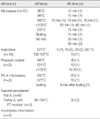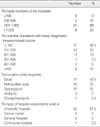1. Harvey JM, Clark GM, Osborne CK, Allred DC. Estrogen receptor status by immunohistochemistry is superior to the ligand-binding assay for predicting response to adjuvant endocrine assay for predicting response to adjuvant endocrine therapy in breast cancer. J Clin Oncol. 1999. 17:1474–1481.
2. Greene GL, Nolan C, Engler JP, Pjensen EV. Monoclonal antibodies to human estrogen receptor. Proc Natl Acad Sci U S A. 1980. 77:5115–5119.

3. Greene GL, Jensen EV. Monoclonal antibodies as probes for estrogen receptor detection and characterization. J Steroid Biochem. 1982. 16:353–359.

4. Alberts SR, Ingle JN, Roche PR, Cha SS, Wold LE, Farr GH Jr, et al. Comparison of estrogen receptor determinations by a biochemical ligand-binding assay and immunohistochemical staining with monoclonal antibody ER1D5 in females with lymph node positive breast carcinoma entered on two prospective clinical trials. Cancer. 1996. 78:764–772.

5. Barnes DM, Harris WH, Smith P, Millis RR, Rubens RD. Immunohistochemical determination of oestrogen receptor: comparison of different methods of assessment of staining and correlation with clinical outcome of breast cancer patients. Br J Cancer. 1996. 74:1445–1451.

6. Barnes DM, Millis RR, Beex LV, Thorpe SM, Leake RE. Increased use of immunohistochemistry for oestrogen receptor measurement in mammary carcinoma: the need for quality assurance. Eur J Cancer. 1998. 34:1677–1682.

7. Rhodes A, Jasani B, Barnes DM, Bobrow LG, Miller KD. Reliability of immunohistochemical demonstration of oestrogen receptors in routine practice: interlaboratory variance in the sensitivity of detection and evaluation of scoring systems. J Clin Pathol. 2000. 53:125–130.

8. Rhodes A, Jasani B, Balaton AJ, Barnes DM, Anderson E, Bobrow LG, et al. Study of interlaboratory reliability and reproducibility of estrogen and progesterone receptor assays in Europe. Am J Clin Pathol. 2001. 115:44–58.

9. Mann GB, Fahey VD, Feleppa F, Buchanan MR. Reliance on hormone receptor assays of surgical specimens may compromise outcome in patients with breast cancer. J Clin Oncol. 2005. 23:5148–5154.

10. Rudiger T, Hofler H, Kreipe HH, Nizze H, Pfeifer U, Stein H, et al. Quality assurance in immunohistochemistry: results of an interlaboratory trial involving 172 pathologists. Am J Surg Pathol. 2002. 26:873–882.
11. Joo HJ. Committee for Quality Control of the Korean Society of Pathologists. Quality control for immunohistochemistry. Manual for Quality Control. 2006. Seoul: Designmecca;139–156.
12. Taylor CR. FDA issues final rule for classification and reclassification of immunohistochemistry reagents and kits. Am J Clin Pathol. 1999. 111:443–444.

13. Rhodes A, Jasani B, Balaton AJ, Miller KD. Immunohitochemical demonstration of oestrogen and progesterone receptors: correlation of standards achieved on in house tumours with that achieved on external quality assessment material in over 150 laboratories from 26 countries. J Clin Pathol. 2000. 53:292–301.

14. Fitzgibbons PL, Page DL, Weaver D, Thor AD, Allred DC, Clark GM, et al. Prognostic factors in breast cancer. College of American Pathologists Consensus Statement 1999. Arch Pathol Lab Med. 2000. 124:966–978.
15. Goldhirsch A, Glick JH, Gelber RD, Coates AS, Thurlimann Bsenn HJ. Meeting highlights: international expert consensus on the primary therapy of early breast cancer 2005. Ann Oncol. 2005. 16:1569–1583.

16. Umemura S, Kurosumi M, Moriya T, Oyama T, Arihiro K, Yamashita H, et al. Immunohistochemical evaluation for hormone receptors in breast cancer: a practically useful evaluation system and handling protocol. Breast Cancer. 2006. 13:232–235.

17. Yun YH, Park SM, Noh DY, Nam SJ, Ahn SH, Park BW, et al. Trends in breast cancer treatment in Korea and impact of compliance with consensus recommendations on survival. Breast Cancer Res Treat. 2007. 106:245–253.








 PDF
PDF ePub
ePub Citation
Citation Print
Print






 XML Download
XML Download